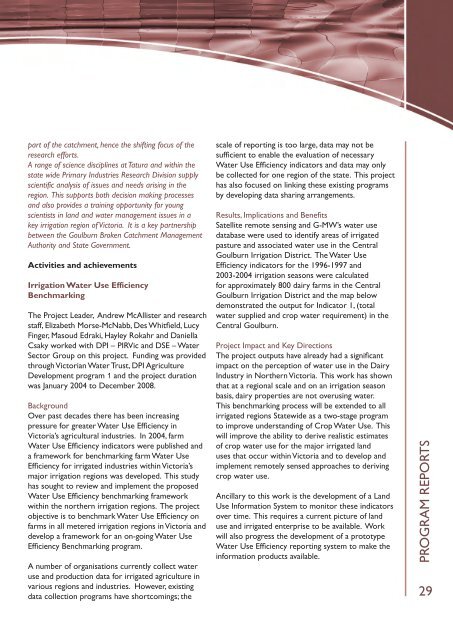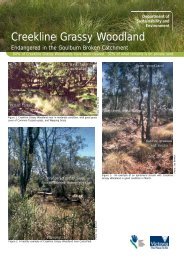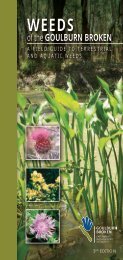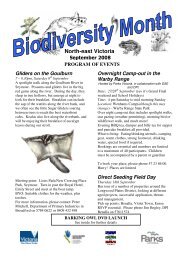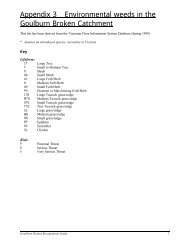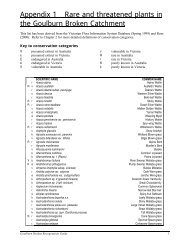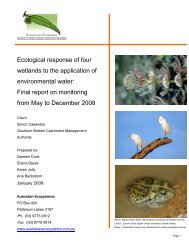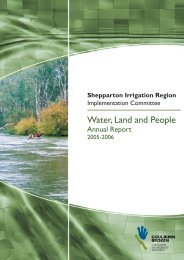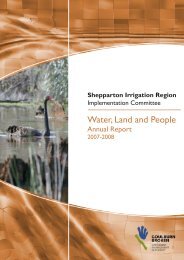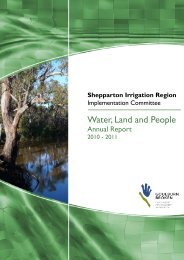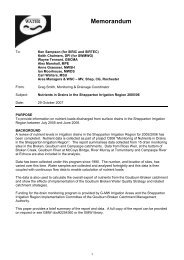Water, Land and People - Goulburn Broken Catchment ...
Water, Land and People - Goulburn Broken Catchment ...
Water, Land and People - Goulburn Broken Catchment ...
You also want an ePaper? Increase the reach of your titles
YUMPU automatically turns print PDFs into web optimized ePapers that Google loves.
part of the catchment, hence the shifting focus of the<br />
research efforts.<br />
A range of science disciplines at Tatura <strong>and</strong> within the<br />
state wide Primary Industries Research Division supply<br />
scientific analysis of issues <strong>and</strong> needs arising in the<br />
region. This supports both decision making processes<br />
<strong>and</strong> also provides a training opportunity for young<br />
scientists in l<strong>and</strong> <strong>and</strong> water management issues in a<br />
key irrigation region of Victoria. It is a key partnership<br />
between the <strong>Goulburn</strong> <strong>Broken</strong> <strong>Catchment</strong> Management<br />
Authority <strong>and</strong> State Government.<br />
Activities <strong>and</strong> achievements<br />
Irrigation <strong>Water</strong> Use Efficiency<br />
Benchmarking<br />
The Project Leader, Andrew McAllister <strong>and</strong> research<br />
staff, Elizabeth Morse-McNabb, Des Whitfield, Lucy<br />
Finger, Masoud Edraki, Hayley Rokahr <strong>and</strong> Daniella<br />
Csaky worked with DPI – PIRVic <strong>and</strong> DSE – <strong>Water</strong><br />
Sector Group on this project. Funding was provided<br />
through Victorian <strong>Water</strong> Trust, DPI Agriculture<br />
Development program 1 <strong>and</strong> the project duration<br />
was January 2004 to December 2008.<br />
Background<br />
Over past decades there has been increasing<br />
pressure for greater <strong>Water</strong> Use Efficiency in<br />
Victoria’s agricultural industries. In 2004, farm<br />
<strong>Water</strong> Use Efficiency indicators were published <strong>and</strong><br />
a framework for benchmarking farm <strong>Water</strong> Use<br />
Efficiency for irrigated industries within Victoria’s<br />
major irrigation regions was developed. This study<br />
has sought to review <strong>and</strong> implement the proposed<br />
<strong>Water</strong> Use Efficiency benchmarking framework<br />
within the northern irrigation regions. The project<br />
objective is to benchmark <strong>Water</strong> Use Efficiency on<br />
farms in all metered irrigation regions in Victoria <strong>and</strong><br />
develop a framework for an on-going <strong>Water</strong> Use<br />
Efficiency Benchmarking program.<br />
A number of organisations currently collect water<br />
use <strong>and</strong> production data for irrigated agriculture in<br />
various regions <strong>and</strong> industries. However, existing<br />
data collection programs have shortcomings; the<br />
scale of reporting is too large, data may not be<br />
sufficient to enable the evaluation of necessary<br />
<strong>Water</strong> Use Efficiency indicators <strong>and</strong> data may only<br />
be collected for one region of the state. This project<br />
has also focused on linking these existing programs<br />
by developing data sharing arrangements.<br />
Results, Implications <strong>and</strong> Benefits<br />
Satellite remote sensing <strong>and</strong> G-MW’s water use<br />
database were used to identify areas of irrigated<br />
pasture <strong>and</strong> associated water use in the Central<br />
<strong>Goulburn</strong> Irrigation District. The <strong>Water</strong> Use<br />
Efficiency indicators for the 1996-1997 <strong>and</strong><br />
2003-2004 irrigation seasons were calculated<br />
for approximately 800 dairy farms in the Central<br />
<strong>Goulburn</strong> Irrigation District <strong>and</strong> the map below<br />
demonstrated the output for Indicator 1, (total<br />
water supplied <strong>and</strong> crop water requirement) in the<br />
Central <strong>Goulburn</strong>.<br />
Project Impact <strong>and</strong> Key Directions<br />
The project outputs have already had a significant<br />
impact on the perception of water use in the Dairy<br />
Industry in Northern Victoria. This work has shown<br />
that at a regional scale <strong>and</strong> on an irrigation season<br />
basis, dairy properties are not overusing water.<br />
This benchmarking process will be extended to all<br />
irrigated regions Statewide as a two-stage program<br />
to improve underst<strong>and</strong>ing of Crop <strong>Water</strong> Use. This<br />
will improve the ability to derive realistic estimates<br />
of crop water use for the major irrigated l<strong>and</strong><br />
uses that occur within Victoria <strong>and</strong> to develop <strong>and</strong><br />
implement remotely sensed approaches to deriving<br />
crop water use.<br />
Ancillary to this work is the development of a <strong>L<strong>and</strong></strong><br />
Use Information System to monitor these indicators<br />
over time. This requires a current picture of l<strong>and</strong><br />
use <strong>and</strong> irrigated enterprise to be available. Work<br />
will also progress the development of a prototype<br />
<strong>Water</strong> Use Efficiency reporting system to make the<br />
information products available.<br />
PROGRAM REPORTS<br />
29


